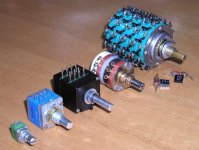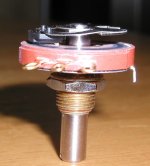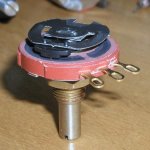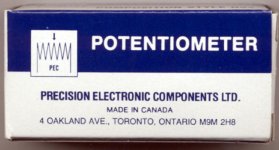Recently I've been experimenting a bit with different pots. Here's what I tried (from left): Taiwan Alpha, Panasonic, Nobel, PEC carbon, discreet switcher based on fixed series Vishay/tantalum and switching Holcos for shunt.
None of those pots is completely neutral and all of them show their sonic signature when placed at amp's input.
None of those pots is completely neutral and all of them show their sonic signature when placed at amp's input.
Attachments
Peter Daniel said:None of those pots is completely neutral and all of them show their sonic signature when placed at amp's input.
I suppose that you are comparing pots/switches with the same impedance?
Let's say, are they all 50k log?
With no input buffer (just a pot as a "passive pre") what works best is 10k.
So deciding on using one or the other will greatly depend on personal taste (and the rest of the system).
Panasonic was the first one I evaluated. It has very natural sound and it is a rather musical pot. It's signature reminds of Panasonic FC capacitors: involving presentation. The only reservation I had here was the way it was softening the top end. But again, in some systems it may be desirable.
Nobel sounds cleaner than Panasonic and has more high frequency extention, however it's not as musical. If you fancy musicality, you'd better suited with Panasonic, if detail and speed is your thing, Nobel may be the right choice.
Two days ago I received this Alpha pot from Jaycar in New Zeland. As you see, it's very tiny and it could easily fit in a Walkman. It made very favourable first impression. It's not completely neutral, as it shows some slight coloration in upper midrange, but it's not very obvious. Also the detail is very good, but not as good as straight wire.
What I noticed comparing to Nobel, was slight loss of clarity and a bit less of separation and layering of instruments. It seemed that Alpha may had touch more bass
None of those pots was better than a switching volume attenuator built from discreet resistors.
Panasonic was the first one I evaluated. It has very natural sound and it is a rather musical pot. It's signature reminds of Panasonic FC capacitors: involving presentation. The only reservation I had here was the way it was softening the top end. But again, in some systems it may be desirable.
Nobel sounds cleaner than Panasonic and has more high frequency extention, however it's not as musical. If you fancy musicality, you'd better suited with Panasonic, if detail and speed is your thing, Nobel may be the right choice.
Two days ago I received this Alpha pot from Jaycar in New Zeland. As you see, it's very tiny and it could easily fit in a Walkman. It made very favourable first impression. It's not completely neutral, as it shows some slight coloration in upper midrange, but it's not very obvious. Also the detail is very good, but not as good as straight wire.
What I noticed comparing to Nobel, was slight loss of clarity and a bit less of separation and layering of instruments. It seemed that Alpha may had touch more bass
None of those pots was better than a switching volume attenuator built from discreet resistors.
Re: Re: So I did try all those different potentiometers
Yes indeed. All of them are 50k, log.
carlosfm said:
I suppose that you are comparing pots/switches with the same impedance?
Let's say, are they all 50k log?
With no input buffer (just a pot as a "passive pre") what works best is 10k.
Yes indeed. All of them are 50k, log.
I left the best for last.
Recently, a forum member suggested to me trying the carbon pot from Precision Electronic Components. Digi-Key carries mono versions of the pot, but since the company is located in Toronto, I didn't have problem with sourcing few samples of a stereo version.
After I substituted my previous reference (discreet switcher) with this carbon pot, I was simply blown away.
None of the previously described potentiometers, or even the switching attenuator, had the amount of musicality and coherence that this carbon pot presents. I like it a lot, as it actually sounds like music. The other attenuators are more mechanical in character, what makes music sound more artificial.
After longer periods of evaluation, I noticed that the signature of this pot is pretty strong. It shows some tubiness, or "mushy" sound. For instance, Nobel sounds much cleaner, but again, less involving. There is no loss in detail however, and the resolution in highs is very good.
I tried to eliminate somehow this signature and soldered 22k nude Vishay parallel to IN/ OUT pins on the pot. Indeed it reduced the tuby sound, made things more bright, but the musicality disappeared somewhat as well. I guess it's better to leave it as it is.
It is my current pot of choice, and actually I have a hrad time deciding if I prefer listening with ML380 premap, or just this carbon pot.
As good as the preamp is (it's a modified unit) it still has some traces of 'processed' music. Listening to pot directly makes the presentation more spontaneous and more involving.
After saying that, and after some cosultations with friends, nothing beats S&B TVC line stage so far, none of those pots and probably not even modified ML380 preamp
Here's the pic of the inside of PEC pot.
Recently, a forum member suggested to me trying the carbon pot from Precision Electronic Components. Digi-Key carries mono versions of the pot, but since the company is located in Toronto, I didn't have problem with sourcing few samples of a stereo version.
After I substituted my previous reference (discreet switcher) with this carbon pot, I was simply blown away.
None of the previously described potentiometers, or even the switching attenuator, had the amount of musicality and coherence that this carbon pot presents. I like it a lot, as it actually sounds like music. The other attenuators are more mechanical in character, what makes music sound more artificial.
After longer periods of evaluation, I noticed that the signature of this pot is pretty strong. It shows some tubiness, or "mushy" sound. For instance, Nobel sounds much cleaner, but again, less involving. There is no loss in detail however, and the resolution in highs is very good.
I tried to eliminate somehow this signature and soldered 22k nude Vishay parallel to IN/ OUT pins on the pot. Indeed it reduced the tuby sound, made things more bright, but the musicality disappeared somewhat as well. I guess it's better to leave it as it is.
It is my current pot of choice, and actually I have a hrad time deciding if I prefer listening with ML380 premap, or just this carbon pot.
As good as the preamp is (it's a modified unit) it still has some traces of 'processed' music. Listening to pot directly makes the presentation more spontaneous and more involving.
After saying that, and after some cosultations with friends, nothing beats S&B TVC line stage so far, none of those pots and probably not even modified ML380 preamp
Here's the pic of the inside of PEC pot.
Attachments
This is what I've been told with regards to their build quality:
Instead of cheap silkscreened resistive elements, they use a hot molded
carbon element, the same hot molded process used for making carbon comp
fixed resistors.
Instead of using silkscreened conductor paths with the terminals riveted to
them (because you can't solder to the silver-loaded epoxy), they use solid
one-piece terminals.
Instead of using spring metal for the wiper conductor, they use a solid
molded slug of carbon. It fits into a molded piece of plastic which is
attached to a spring metal disc to provide the contact pressure.
Attachments
Konnichiwa,
Try this:
Use a 1M Linear law version of the Carbon track pot you use.
Use 33-47k Law Fake resistor across out & gnd, use whatever sounds best to you, Carbon composition would be my take.
If you where still using the IGC Circuit with a 10K input Impedance I'd recommend simply a 250K Lin version of this pot, input impedance lawfakes by itself....
Sayonara
Peter Daniel said:None of the previously described potentiometers, or even the switching attenuator, had the amount of musicality and coherence that this carbon pot presents. I like it a lot, as it actually sounds like music. The other attenuators are more mechanical in character, what makes music sound more artificial.
Try this:
Use a 1M Linear law version of the Carbon track pot you use.
Use 33-47k Law Fake resistor across out & gnd, use whatever sounds best to you, Carbon composition would be my take.
If you where still using the IGC Circuit with a 10K input Impedance I'd recommend simply a 250K Lin version of this pot, input impedance lawfakes by itself....
Sayonara
Everytime I put a good pre instead of the passive pot I hear improvements.
Clearer, more definition, real harmonics.
I've tested this too many times.
Last week again.
A pot as a passive pre.
Then, an op-amp after it.
Bingo.
An open window.
 The pot was the same, I've just put a TPA6120 after it.
The pot was the same, I've just put a TPA6120 after it.
Yes, a good pre can be just as simple as using the right op-amp.
Too many parts and too long a signal path just throws it all away.
Clearer, more definition, real harmonics.
I've tested this too many times.
Last week again.
A pot as a passive pre.
Then, an op-amp after it.
Bingo.
An open window.
 The pot was the same, I've just put a TPA6120 after it.
The pot was the same, I've just put a TPA6120 after it.
Yes, a good pre can be just as simple as using the right op-amp.
Too many parts and too long a signal path just throws it all away.

Hello Peter,
Thank you for taking the time to share with us your findings. Funny enough, I was just thinking about getting some pots for my experimental rig with Behringer xover.
I always find your posts very interesting, detailed and informative, and I always enjoy reading them.
Stay well
AR2
Thank you for taking the time to share with us your findings. Funny enough, I was just thinking about getting some pots for my experimental rig with Behringer xover.
I always find your posts very interesting, detailed and informative, and I always enjoy reading them.
Stay well
AR2
carlosfm said:Everytime I put a good pre instead of the passive pot I hear improvements.
Clearer, more definition, real harmonics.
I've tested this too many times.
Last week again.
A pot as a passive pre.
Then, an op-amp after it.
Bingo.
An open window.
The pot was the same, I've just put a TPA6120 after it.

Yes, a good pre can be just as simple as using the right op-amp.
Too many parts and too long a signal path just throws it all away.
It is my observation that a quality of the pot IS very critical (when placed at amp's input). It may make or brake the sound of the amp. When properly chosen it will will sound cleaner and more natural than even a very good active stage.
So far I didn't find the active stage I can live with in a long run. But I can live with a good pot. And as I said already, the passive TVC stage is probably most "pure" sounding of them all.
In closing, one can't argue about the value Alpha pot offers. For the money, it's a bargain, I think.
x. onasis said:Any idea where others may source this pot? Or maybe series and style #'s for a search?
Which one?
Here it is: http://dkc3.digikey.com/PDF/T043/1010.pdf
I was using KA series, and DK carries only mono version.
Attached company info.
I was using KA series, and DK carries only mono version.
Attached company info.
Attachments
Hi Peter,
Glad to read your report and quite a coincidence as I've also been testing pots for a project, all carbon linear 1m and law faked. They replace an Alps Blue in a tubed headphone amp. By comparison the Alps is shrill and thinned out. The Alpha (not same one you tested) is more full-bodied but a little 'smudged' around the edges. Another no-name bought at a radio parts shop was similar. But I was bowled over with the PEC 1m linear + tants. It is more dynamic, detailed, transparent and full sounding than the Alps by far. I wouldn't have believed it.
Brian
Glad to read your report and quite a coincidence as I've also been testing pots for a project, all carbon linear 1m and law faked. They replace an Alps Blue in a tubed headphone amp. By comparison the Alps is shrill and thinned out. The Alpha (not same one you tested) is more full-bodied but a little 'smudged' around the edges. Another no-name bought at a radio parts shop was similar. But I was bowled over with the PEC 1m linear + tants. It is more dynamic, detailed, transparent and full sounding than the Alps by far. I wouldn't have believed it.
Brian
x. onasis said:
Maybe. We managed to obtain samples within a week.
bcherry said:but a little 'smudged' around the edges
That's exactly expression I was looking for.
Yes, the PEC pot is definitely something special. I didn't expect that a pot can sound like that. You know, I was always using those plastic types
My thanks go to SE, for pointing it out to me.
Peter Daniel said:You know, I was always using those plastic ones
Have you tried the metal ones, a wirewound? A ten turn with vernier dial gives one thousand defined volume settings so the fact wirewounds are normally linear taper isn't a real disadvantage. Plenty of resolution remains at the bottom end of the scale. To my ear precise channel balance is critical to achieving a proper sense of space and for that reason can't live with discrete resistor attenuators. I also like the theoretical aspect that audio current never leaves metal and doesn't pass through carbon or plastic though I can't claim it's an audible advantage.
I've used a Bourns 10k's in a passive (with hot and ground switching pgm selector) for ten years now and never felt the need to change it. My impression is the pot does have a sound, midly subtractive and benign but no where near the effect I hear by changing out a coupling cap or interconnects. I'd be curious if anyone else here uses or has experience with them.
rdf said:My impression is the pot does have a sound, midly subtractive and benign but no where near the effect I hear by changing out a coupling cap or interconnects.
Whyzzat that everybody with standalone passive "pre-amps" always end up spending big money on interconnects?
To my ear precise channel balance is critical to achieving a proper sense of space and for that reason can't live with discrete resistor attenuators.
I don't know what attenuators you have listened to but presume they must have used un-matched 5% resistors (or worse).
An attenauator using 1% metal films will give you better channel matching than virtually any pot!
- Status
- This old topic is closed. If you want to reopen this topic, contact a moderator using the "Report Post" button.
- Home
- Amplifiers
- Chip Amps
- So I did try all those different potentiometers



